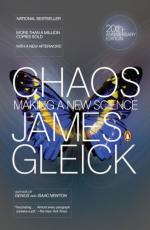
|
| Name: _________________________ | Period: ___________________ |
This test consists of 5 multiple choice questions, 5 short answer questions, and 10 short essay questions.
Multiple Choice Questions
1. Gleick compares the Mandlebrot Set to what set in Chapter 8, "Images of Chaos"?
(a) The Karen Set.
(b) The Julia Set.
(c) The Martha Set.
(d) The Valerie Set.
2. In physics and fluid mechanics, what refers to the layer of fluid in the immediate vicinity of a bounding surface where effects of viscosity of the fluid are considered in detail?
(a) Boundary layer.
(b) Gradient.
(c) Euclidean space.
(d) Cantor dust.
3. Where is Michael Barnsley from?
(a) England.
(b) Poland.
(c) Spain.
(d) Scotland.
4. Where was Heinz-Otto Peitgen born?
(a) Johannesburg, South Africa.
(b) Nümbrecht, Germany.
(c) Warsaw, Poland.
(d) Nimbin, Australia.
5. What exists when a reversible reaction ceases to change its ratio of reactants/products, but substances move between the chemicals at an equal rate, meaning there is no net change?
(a) Euclidean space.
(b) Cantor dust.
(c) Dynamic equilibrium.
(d) Energy.
Short Answer Questions
1. What refers to a physical science that studies the effects on material bodies, and on radiation in regions of space, of transfer of heat and of work done on or by the bodies or radiation?
2. Who began to call the global construction of fractals "the chaos game" according to the author in Chapter 8, "Images of Chaos"?
3. If a system is in what state, then the recently observed behavior of the system will continue into the future?
4. In physics and systems theory, what states that, for all linear systems, the net response at a given place and time caused by two or more stimuli is the sum of the responses which would have been caused by each stimulus individually?
5. Where was Mitchell Feigenbaum born?
Short Essay Questions
1. How is the Taylor-Couette flow defined?
2. What was Harry Swinney known for in Chapter 5, "Strange Attractors"? Where did his interests lie?
3. What problems did turbulence cause for physicists and scientists, according to the author in Chapter 5, "Strange Attractors"?
4. How are the Navier-Stokes equations defined? For whom are they named?
5. What interests in art and culture are described of Mitchell Feigenbaum in Chapter 6, "Universality"?
6. How is turbulence defined in Chapter 5, "Strange Attractors"?
7. Who was Johann Wolfgang von Goethe? For what great work is he most well known?
8. How are Feigenbaum constants defined?
9. How does the author describe the evolution of chaos in Chapter 8, "Images of Chaos"?
10. Where did Mitchell Feigenbaum meet Michael Barnsley in Chapter 8, "Images of Chaos"? What did their discussions lead to?
|
This section contains 883 words (approx. 3 pages at 300 words per page) |

|




